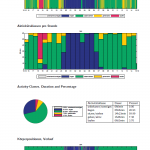DataAnalyzer – Sensor Data Analysis
The movisens DataAnalyzer processes raw sensor data to calculate physiological parameters with a selectable output interval in just a few clicks.
The DataAnalyzer extracts the selected parameters into .csv format, allowing researchers to delve deeper and process the data further in Excel or SPSS. For a big picture overview, our pdf reports provide a great summary of the key information extracted from the sensor in easy to read charts and tables.
The software package works with raw sensor data saved in the unisens format, and complements our range of physiological sensors (Move 4, EcgMove 4, LightMove 4, EdaMove 4). The DataAnalyzer also allows the batch processing of an entire study cohort, automatically displaying the available parameters based on the sensor type, and wear position.
As with our sensors, the DataAnalyzer is a one-off purchase with no renewal or subscription fees. Once you pay for it, you own it. It comes standard with algorithms that allow the calculation of physical parameters derived from the data gathered by the class leading accelerometers featured in all of our sensors.
The following additional modules are available for individual purchase:
- Energy Expenditure
- Cardio/HRV
- Electrodermal Activity
- Sleep
- Ambient Light
- Physical Activity Metrics
Top features
- Batch analyze complete studies with one click
- Selectable output parameters
- Configurable output intervals
- Optimized output that's suitable for further processing (Excel, SPSS)
- Integrated generator of informative PDF reports
Applications
- Analysis of activity, ECG and EDA measurement data
- Activity recognition and energy expenditure calculation
- Heart rate and heart rate variability
- Electrodermal activity
- Research of the autonomic nervous system (ANS)
- Behavioral monitoring
- Psycho-physiological stress monitoring
Matching products and services
Description of Modules
Included as standard with the DataAnalyzer software licence, the algorithms allow the analysis of the physical activity data collected from the Move 4, LightMove 4, EcgMove 4, and EdaMove 4 sensors. You can select from the following output parameters:
- Body Position
- Acceleration along the body axis
- Steps
- Activity class
- Inclination of body
- Altitude
- Vertical speed
- Physical activity report (PDF) - A detailed report including hourly summaries of body position, activity intensity, steps, etc… presented in an easy to read chart format.

With the Energy Expenditure Module you can analyze physical activity data of the sensors Move 4 and EcgMove 4 with regards to energy expenditure. The following output parameters are available:
- Activity Energy Expenditure
- Total Energy Expenditure
- Metabolic Equivalent of Task / MET
- Energy expenditure summary
- Physical activity and energy expenditure report (PDF) – A detailed report displaying the physical activity (activity intensity, body position, steps, etc…) in addition to the energy expenditure of the participant/s. Charts depict an hour by hour analysis of Energy expenditure and MET levels.

With the Cardo/HRV-Module you can analyze the ECG signal data obtained by the EcgMove 4, either by generating a detailed Heart Rate Variability report or extracting information on the following parameters:
- ECG R peaks
- Normal beats and intervals
- Beat by beat heart rate
- Heart rate
- HRV parameter Low Frequency (LF)
- HRV parameter High Frequency (HF)
- HRV parameter Low to High Frequency Ratio (LF/HF)
- HRV parameter SDNN
- HRV parameter RMSSD
- HRV parameter SD1
- HRV parameter SD2
- HRV parameter SD2/SD1
- HRV report (PDF) - A detailed report displaying a HRV Spectogram in addition to charts displaying Heart Rate, the Baevskii Stress Index, LF to HF ratios, and activity classes of a participant/s. The report concludes with a table displaying the overall HRV parameters and Activity classes of the participant/s.

With the EDA Module you can analyze the EDA data captured by the sensor EdaMove 3. The following output parameters are available:
- Electrodermal Activity report as text file
- Skin conductance level
- SCR amplitudes
- SCR rise times
- SCR Energies
- SCR half recovery times
- Number of SCR
- Mean of SCR Amplitudes
- Mean of SCR rise times
- Mean of SCR energy
- Mean of SCR recovery times

Whith the Sleep-Module you can analyze the data captured by the sensor Move 4, LightMove 4, ECGMove 4 und EdaMove 4, Move 3, LightMove 3, ECGMove 3 und EdaMove 3. The following output parameters are available:
- Sleep/wake detection
- Lights out detection

Whith the Ambient Light-Module you can analyze the data captured by the sensor LightMove 3. The following output parameters are available:
- Illumination
- Color Temperature
- Light Situation detection

With the Physical Activity Metrics you can analyze acceleration data from all of the movisens sensors and calculate commonly used physical activity metrics. Physical activity metrics are algorithms to aggregate raw accelerations signals acquired by acceleration sensors to values that correlate with the intensity of physical activity of a person wearing the acceleration sensor. The following output parameters are available:
- Euclidian Norm (EN)
- Eucldian Norm Minus One (ENMO)
- HFEN, BFEN, HFEN+
- Zero Crossing
- Proportional Integrating Measure (PIM)
- Mean Amplitude DeviationMean (MAD)
- ActiWatch 4 counts

Downloads
| Newsletter |
|
|---|---|
| Software |
|
| Manuals |
|
| Data examples |
|
| Example reports | |
| External Tools |
System Requirements
The DataAnalyzer needs the following:
- A PC with Microsoft Windows 7 or higher, 64bit
- Microsoft Excel for reports in Excel format
- Administrator rights during installation
- A minimum of 2.1 GB free space on hard disc
Change history
- Bugfix: Make sure that the parameter threeHipPositions is taken into consideration when generating report.
- Add new output parameter called paMetricActigraphCountsVectorMagnitude, that computes the vector magnitude of ActiGraph counts, averaged over the output interval.
- Expand the possibilities of physical activity metrics to choose from for the calculation of Activity Level (ActivityLevelFromPaMetric).
- Bugfix: output parameters paMetricActigraphCountsActiLifeDown, paMetricActigraphCountsActiLifeForward, paMetricActigraphCountsActiLifeRight are now shown in Results.xlsx file.
- Correct any missing explanations for output parameters.
- Implement the ActiLife Algorithm from https://github.com/actigraph/agcounts.git to calculate the ActiGraph counts.
- Add additional output parameters for DataAnalyzer: PaMetricActigraphCountsActiLifeDown, PaMetricActigraphCountsActiLifeForward, PaMetricActigraphCountsActiLifeRight.
- Bugfix for altitude calculation: Ensure that indices are always positive.
- Changes affect the output parameter NonWearSleepWake. They improve the detection of extended periods when sensor is not worn.
- Bugfix in activity pdf reports (ReportActivity.pdf and ReportActivityEe.pdf). The 'total' parameter in activity class table shows now the full day as 24 hours.
- Make alignment at midnight optional for output parameters ReportActivityEeSummary.xlsx and ReportActivitySummary.xlsx.
- Add new column to Results.xlsx table that documents the markers set in signal marker.csv.
- Bugfix in activity excel reports (ReportActivityEeSummary.xlsx and ReportActivitySummary.xlsx). The parameter "Average of full days" now shows the last day as a full day when the recoding of the last day is exactly 24 hours.
- Bugfix in plot energy expenditure summary.
- New Parameter: ActivityLevelFromPaMetric
- Bugfix: Check minimal amount of data needed for Step Count Summary.
- Bugfix in function listing available activity classes for reports.
- Make additional outputs visible for DataAnalyzer: BeatDropReason, EcgValidSeg, HrvIsValid, HrIsValid.
- Output ReportSleepPdf even when body position is not calculable.
- Separate light activity level time into not active level time and light level time in ReportActivityEESummaryExcel.
- Calculate reports when the parameter threeHipPositions is set to true.
- Set ColorTemperature to -1 if cannot be calculated.
- Add additional outputs HrvIsValid and HrIsValid
- Activated PaMetrics in Test License
- Optimized license code parser
- Fix error in CalcReportSleep
- Make body positions optional for ReportSleepPdf
- Change reportSleep name to reportSleepPdf
- Add description for reportSleep
- Set colorTemperature to -1 if it is not calculable
- Fixed bug in ReportActivityEeSummaryExcel by separating light activity level time into not active level time and light level time
- Fix Bug in HRV Segmentation, Welch algorithm for small windows
- For non wear detection output enum nonWear always when sensor is charging
- Add new report for sleep
- Add movement acceleration information for reports ActivitySummaryExcel and ActivityEeSummaryExcel
- Add reports ActivitySummaryPdf and ActivitySummaryShortPdf for sensor location ankle, upper arm and thigh without EE and Met plots
- Improve Altitude Filtering
- PaMetricPim: Allow calculation of PaMetricPim with all acceleration signal sample rates (other than 64Hz)
- PaMetricAiAbs: remove noise floor according to sensor type
- Add MovementAcceleration to ReportActivitySummaryExcel and ReportActivityEeSummaryExcel
- Bug fix in wear detection
- Enable ReportActivitySummaryPdf and ReportActivitySummaryShortPdf for sensor location ankle
- Bugfix: DataAnalyzerCmd now considers option targetPath
- Bugfix: ReportActivityPdf now works for sensor location ankle
- Bugfix: Added missing translations for measurement parameters in GUI
- Bugfix: Correct calculation of absolute date/time after more than ~24days in Results.xlsx
- Bugfix: Correct unit for EdaScrHalfRecoveryTimes
- Show metEpoch length in ReportEeSummaryExcel
- Added new module for physical activity metrics
- Add cycling detection
- Added new output parameter for sedentariness
- Add functions to generate 3 body positions for sensor location hip
- Add body position calculation for ankle
- Improve bodyposition calculation
- Bugfix: Allow summary reports longer than 9 days
- Bugfix: Custom algorithm configurations now work for DataAnalyzerCmd
- Bugfix: Correct output of Results.xlsx Excel-Files for empty SignalEntries at the end of measurements
- Added functionality to allow custom algorithm configurations
- Added parameters for hrv frequency bands
- Fixed missing translations of footer in reports
- Improved sanity check for MET values
- Fixed translations in StepCount summary plot
- Added missing sensor position left_side_hip for Move II
- Added New Excel Summary Report without Ee data in Base module
- Added handling of manual marked artifacts in ECG
- Added support for 4th sensor generation
- Bugfix in CalcLightsOut Parameter
- Bugfix in ReportTableHrvAndActivity Parameter
- Bugfix in Baevsky Stress Index Algorithm for very small variabilities
- Bugfix: output ReportHrvPdf for all days of measurement
- Bugfix: Calculate Baevsky Stress Index correctly for small variabilities
- Added 4k display support
- Bugfix: Stop calculation if message box is closed
- Bugfix: Prevent deletion of destination folder (path not editable)
- Bugfix: Load attributes (age, gender, etc.) from measurement in batch mode
- Added new module Sleep with sleep/wake detection
- Added support for ambient light sensor LightMove3
- Added algorithms for ambient light: illuminance, color temperature, lights out detection
- Improved ECG RR filter
- Improved wear detection algorithm
- New output EDA SCL signal
- Added NonWear, MVPA and MVPA bouts to Summary report
- Added support for unisens-CSV format
- Improved colors in reports for better readability
- Improved report for MET level
- Improved tables in reports
- Better support of different sensor locations in reports
- Improved body position detection for sensor location thigh
- Fixed bug for missing values at the end of Results.xslx
- New PDF reports
- Support for new sensors and sensor positions
- New report generator for PDF reports
- Added wear time detection algorithms
- Improved filtering of RR intervals
- Improved HRV parameter RMSSD
- New algorithms for ambient light sensors (illumination and color temperature)
- No need of LaTeX and Excel as system requirements
- Improved filtering of RR list
- Improved HRV spectral parameter calculation
- Improved AEE, TEE and MET Calculation by using additional Model for slopes
- Bugfixes in PDF reports
- Support for new sensors
- Improved EDA SCR detection
- Added missing parameter EdaScl (Skin Conductance Level)
- New parameter ECG derived respiration (EDR)
- Considering output interval for EdaArousal
- Added sitting/standing detection (sensor position thigh)
- Added temperature parameter
- Added HRV Parameter pNN50
- Output of all selected parameters as Excel including clearly laid out column descriptions (Results.xslx)
- New module for Cardio/HRV with all common parameters, Baevskii Stress Index and a new HRV report as PDF
- New module for EDA with all relevant EDA parameters, including new arousal parameter
- All PDF reports revised and now available in German and English
- New PDF overview report for physical activity
- Improved detection of body positions
- Improved energy expenditure calculation while resting/sitting
- Improved plots and layout in all reports
Literature and Validation
- Predicting the onset of psychotic experiences in daily life with the use of ambulatory sensor data – A proof-of-concept study.
- Impact of a Semi-Rigid Knee Orthotic Intervention on Pain, Physical Activity, and Functional Capacity in Patients with Medial Knee Osteoarthritis.
- Exploring the Link between Lifestyle, Inflammation, and Insulin Resistance through an Improved Healthy Living Index.
- Acute Fasting Modulates Autonomic Nervous System Function and Ambulatory Cardiac Interoception.
- Determination of cut-off points for the Move4 accelerometer in children aged 8–13 years.
- The cardiac correlates of feeling safe in everyday life: A Bayesian replication study.
- Spontaneous infant crying modulates vagal activity in real time.
- Human uncertainty in interaction with a machine: establishing a reference dataset.
- Momentary within-subject associations of affective states and physical behavior are moderated by weather conditions in real life: an ambulatory assessment study.
- Rethinking Learning Experience: How Generally Perceived Life Stress Influences Students’ Course Perceptions in Different Learning Environments.
- Microtemporal Dynamics of Dietary Intake, Physical Activity, and Impulsivity in Adult Attention-Deficit/Hyperactivity Disorder: Ecological Momentary Assessment Study Within Nutritional Psychiatry.
- Ecological Momentary Assessment in Nutritional Psychiatry: Microtemporal Dynamics of Dietary Intake, Physical Activity, and Impulsivity in Adult ADHD.
- The Work Lifestyle-integrated Functional Exercise Program for Preventing Functional Decline in Employees over 55 years: Development and Initial Evaluation.
- Off-the-shelf wearable sensing devices for personalized thermal comfort models: A systematic review on their use in scientific research.
- Does Being Ignored on WhatsApp Hurt? A Pilot Study on the Effect of a Newly Developed Ostracism Task for Adolescents.
- Interactive teaching enhances students' physiological arousal during online learning.
- Tranquillity, transcendence, and retreat: the transformative practice of listening at Evensong.
- Momentary feelings of safety are associated with attenuated cardiac activity in daily life: Preliminary evidence from an ecological momentary assessment study.
- Flow bei der Arbeit greifbar machen.
- Measuring catatonia motor behavior with objective instrumentation.
- Mood-enhancing Physical Activity in Individuals with Attention-Deficit/Hyperactivity Disorder (ADHD) and Healthy Youths – Daily Life Investigations by Ambulatory Assessment.
- Decreased sympathetic cardiovascular influences and hormone-physiological changes in response to Covid-19-related adaptations under different learning environments.
- Deepaware: A hybrid deep learning and context-aware heuristics-based model for atrial fibrillation detection.
- The association of stress and physical activity: Mind the ecological fallacy.
- Combining cardiac monitoring with actigraphy aids nocturnal arousal detection during ambulatory sleep assessment in insomnia.
- The dynamical association between physical activity and affect in the daily life of individuals with ADHD.
- How does it feel to walk in Berlin? Designing an Urban Sensing Lab to explore walking emotions through EDA sensing.
- Assessing New Methods to Optimally Detect Episodes of Non-metabolic Heart Rate Variability Reduction as an Indicator of Psychological Stress in Everyday Life: A Thorough Evaluation of Six Methods.
- Effects of exercise training on heart rate variability in children and adolescents with pulmonary arterial hypertension: a pilot study.
- Effects of Biophilic Interventions in Office on Stress Reaction and Cognitive Function: A Randomized Crossover Study in Virtual Reality.
- Dynamics of Intraindividual Variability in Everyday Life Affect Across
Adulthood and Old Age. - Neural correlates of individual differences in affective benefit of real-life urban green space exposure.
- Sedentary behavior in everyday life relates negatively to mood: An ambulatory Assessment study.
- Brute Force ECG Feature Extraction Applied on Discomfort Detection.
- An experience sampling study on the nature of the interaction between traumatic experiences, negative affect in everyday life, and threat beliefs.
- Immediate and sustained effects of intermittent exercise on inhibitory control and task-related heart rate variability in adolescents.
- Transcutaneous vagus nerve stimulation and emotional inhibition of return.
- A mixed-methods study of physiological reactivity to domain-specific problem solving: methodological perspectives for process-accompanying research in VET.
- Does a 20-week aerobic exercise training programme increase our capabilities to buffer real-life stressors? A randomized, controlled trial using ambulatory assessment.
- Home-based system for physical activity monitoring in patients with multiple sclerosis (Pilot study).
- Using Support Vector Regression for Assessing Human Energy Expenditure Using a Triaxial Accelerometer and a Barometer.
- Classification of Human Physical Activity and Energy Expenditure Estimation by Accelerometry and Barometry.
- A new method to estimate energy expenditure using accelerometry and barometry-based energy models.
- Validity of the kmsMove-sensor in calculating energy expenditure during different walking intensities.
- Estimation of energy expenditure using accelerometers and activity-based energy models - validation of a new device.
- Energieumsatzmessung mit Aktivitätssensoren – Validität des kmsMove-Akzelerometers.
- Heart rate variability: standards of measurement, physiological interpretation and clinical use. Task Force of the European Society of Cardiology and the North American Society of Pacing and Electrophysiology..
You can find more publications here.











